EPOXI
Two intriguing investigations -- One flight-proven spacecraft
Observing Challenge
Observing Challenge
- Observing Mars
- (18 Sep 2009) Mars is a variable object. We could really benefit from Mars observations leading and following our observations by roughly 2 weeks either way (a number pulled out of a hat) -- helpful to identify a global dust storm, for instance. The spacecraft will be too distant to resolve Mars with its defocused camera. Multi-filter observations from all over the world would be most helpful, as we could construct light curves for full rotations if we have data from sufficiently wide-spaced stations. A useful observing sequence would include the following: filters that more or less match the EPOCh filter set (350, 450, 550, 650, 750, 850, 950 nm on center, 100 nm wide [± 50 nm]), especially the 450, 550, 650, and 850 nm filters, and some other object to use for photometric calibration. A field of view that includes Phobos (at 1.4 Mars radii) and/or Deimos (at 3.5 Mars radii) would be especially valuable. If your filters don't match ours, that's okay, but we could use a description of your filters' performance in any case. Mars apparent diameter will vary from 6.9 to 8.2 arcsec from two weeks prior to our observation until two weeks following.
- Observing the Transits
- Amateurs have played in important role in the observations of exoplanet transits. The observations are not easy, but they are doable. To learn more
Observe the stars
Although the transits are very challenging to observe, an easier goal is to just see the target stars. The selected stars are dim because we don't want them to saturate the spacecraft instruments but they are bright enough to be visible in amateur telescopes if the sky conditions are good and the skies are dark.
TrES-3
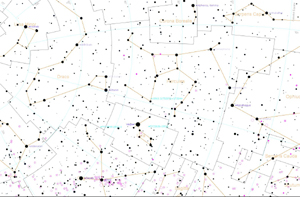 TrES-3
= GSC 03089-00929 is a magnitude 12.4, G-class star located in the constellation Hercules.
TrES-3
= GSC 03089-00929 is a magnitude 12.4, G-class star located in the constellation Hercules.
Top: Shows the position of the star relative to the constellations. North is left and east is down. The constellations are shown as they might appear in the evening sky in the northern hemisphere in spring. During the summer, Hercules is pretty much overhead.
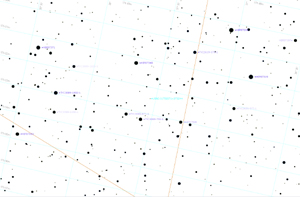 Bottom: TrES-3 is marked as USNO J1752071+373244 in this 2° x 1° field of view along with other stars. The size of the dots is relative to their brightness.
Bottom: TrES-3 is marked as USNO J1752071+373244 in this 2° x 1° field of view along with other stars. The size of the dots is relative to their brightness.
RA: 17h 52m 07.02s
dec: +37° 32' 46.2"
If you need some more help identifying it, there is also a 15'x10' chart.
GJ436
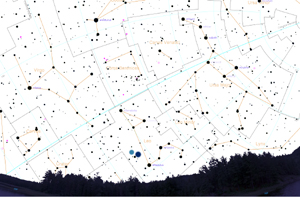 GJ436 = HIP 57087 = LHS310 is a magnitude 10.7, M2.5-class star located in the constellation Leo. At a little over 33 LY, this reddish star is one of the closer ones that EPOCh is observing.
GJ436 = HIP 57087 = LHS310 is a magnitude 10.7, M2.5-class star located in the constellation Leo. At a little over 33 LY, this reddish star is one of the closer ones that EPOCh is observing.
Top: Shows the position of the star relative to the constellations. North is right and east is up. The constellations are shown as they might appear in the evening sky in the northern hemisphere in mid-July.
 Bottom: GJ436 is at the center of this view from Aladin.
Bottom: GJ436 is at the center of this view from Aladin.
RA: 11h 42m 11.09s
dec: +26° 42' 23.7"
HAT-P-4
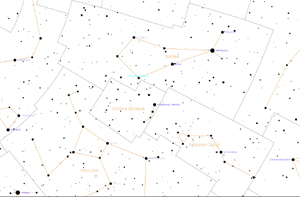 HAT-P-4 = SAO 64638 = TYC 2569-1599-1 is a magnitude 11, G-class star located in the constellation Boötes.
HAT-P-4 = SAO 64638 = TYC 2569-1599-1 is a magnitude 11, G-class star located in the constellation Boötes.
Top: Shows the position of the star relative to the constellations. North is left and east is down. The constellations are shown as they might appear in the evening sky in the northern hemisphere in spring.
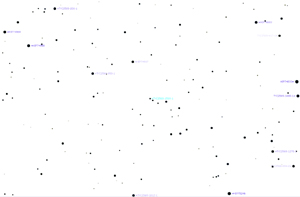 Bottom: HAT-P-4 is marked as TYC 2569-1599-1 in this 2° x 1° field of view along with other stars. The size of the dots is relative to their brightness.
Bottom: HAT-P-4 is marked as TYC 2569-1599-1 in this 2° x 1° field of view along with other stars. The size of the dots is relative to their brightness.
RA: 15h 19m 57.93s
dec: +36° 13' 46.8"
